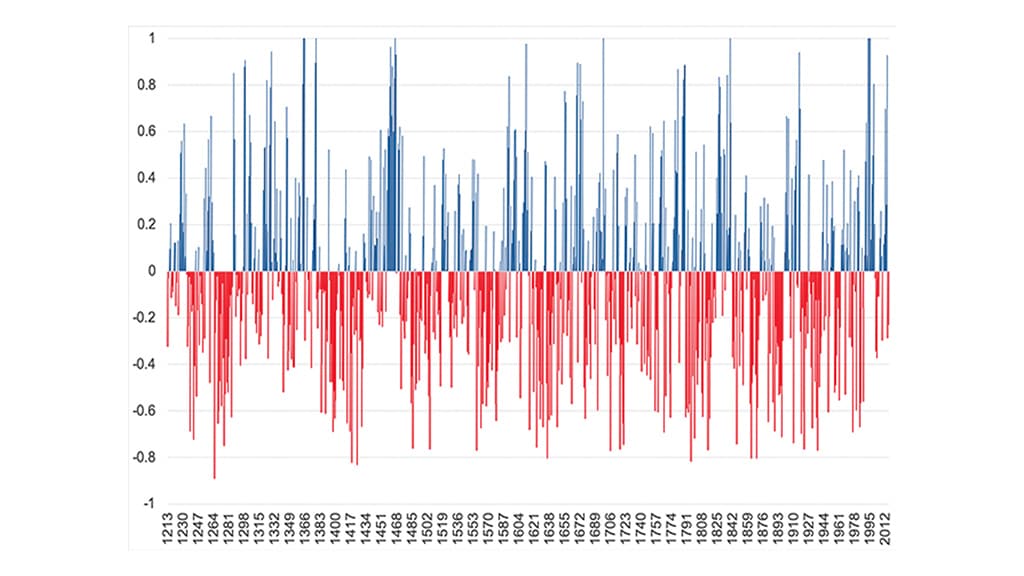
PARC uses tree ring data to assemble a detailed year-by-year record of the prairie's climate that stretches back 1,500 years.
Agriculture, Education June 01, 2024
Land of Extremes
1,500 years of tree ring data shows wild climate swings on the prairies.
by Lorne McClinton
Too hot! Too cold! Too wet! Too dry! There are few places on the planet where the climate swings as dramatically as on the Canadian Prairies. It's become one of the world's great agriculture regions because farmers adapted their farm practices to its climate variability. But David Sauchyn, the director of the Prairie Adaptation Research Collaborative (PARC) in Regina, Sask., says producers will have to step up their game to adapt to climate change.
Sauchyn is a popular speaker. Everywhere he goes people want to know what climatic conditions we can expect in the future.
Unfortunately, he says, the only source of information available are models that simulate the world's climate. These indicate that the prairies are projected to have a more erratic, less predictable climate with more extreme temperatures and precipitation events in the years ahead.
"But how reliable are these projections?" Sauchyn asks. "Climate models are tested against the historical weather records. But we only have accurate records for the past 100 years. We need samples from over a much longer time period for a climate as variable as the prairies', for scientifically valid results."
That's where Sauchyn's tree ring research comes in. For the past 20 years his team has been collecting tree ring data from across the prairies and the northern plains to provide context for weather station and climate model projections. It helps to determine how variable the climate has been in the past, to help project what extreme weather events might look like in the future.
Trees create a yearly record of climatic conditions in their pairs of annual growth rings. Thick rings indicate wet years, narrow rings signify drought. PARC matched the growth patterns in deadfall and living trees to assemble a record of climate conditions stretching back 1,500 years.
Above. David Sauchyn says that knowing how variable the climate has been in the past provides context for weather station and climate model projections of what extreme weather events might look like in the future.
Far worse droughts. The results were ominous. They showed that decade-long droughts, like the one in the 1930s were quite common in the paleo-climate evidence of the tree ring record. Some droughts were far worse than any that have been experienced in recorded history.
The tree ring data also shows why Captain John Palliser famously described the southern Canadian Prairie region, known as the Palliser Triangle, as a desolate place with little potential for agriculture when he assessed the region's agriculture potential in the 1850s. Palliser had arrived during a 20-year drought. If a similar drought hits in the 21st century it will be more severe because the climate is warmer.
PARC is an adaptation research centre. It uses its data to give farmers, organizations, municipalities, and governments an indication of where they expect the climate is heading so they can start changing practices, policies, and adapting infrastructure to withstand a changing climate.
"Our best science indicates that the range of our weather will expand," Sauchyn says. "Wetter years will be wetter and drier years will be drier. A robust set of adaptation strategies and farm practices need to be in place to deal with that variability.
"You want to conserve water," Sauchyn continues. "So, instead of draining all your wetlands, you may want to consolidate them to have one that will store water in the wet years so it's available in the dry years. And if you want to contribute to preventing climate change, you want to store carbon, too. So, the best practices are those that store both carbon and water in the soil." ‡
Read More

AGRICULTURE, LIVESTOCK/POULTRY
Stressing Herd Health
Prevent, observe, and adapt to stay ahead in challenging conditions.

AGRICULTURE, EDUCATION
Another Important Bee
Leafcutter bees help pollinate seed crops.


